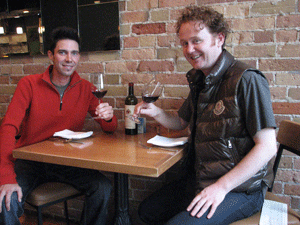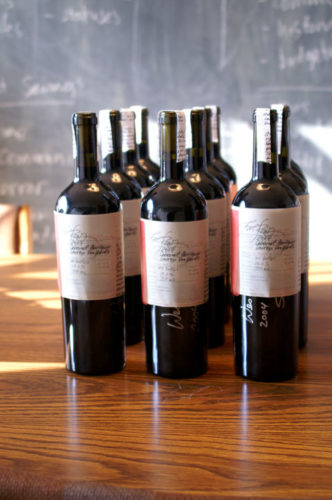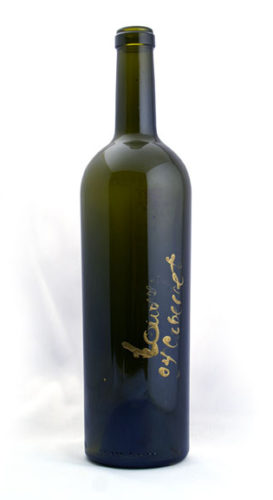Five Rows Launch
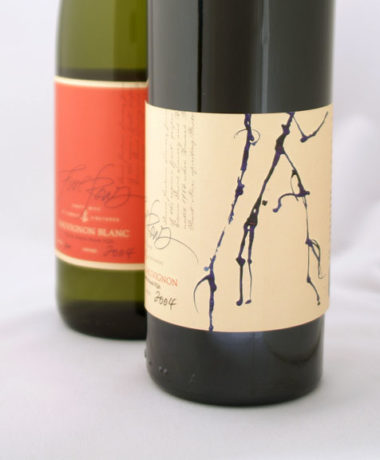
With great excitement we are pleased to announce that our long journey to a finished product is finally nearing completion. Our first wines have passed VQA sensory and lab evaluations, and the labels have gone to press. We are now accepting orders for our Five Rows 2004 Cabernet Sauvignon, 2007 Pinot Gris and 2007 Sauvignon Blanc. These wines will all be available in special 6-bottle case allotments, with red wines retailing for $300/case and whites $150/case. We hope to have a short run of labels in hand soon, however getting labeled wines to customers pre-Christmas might prove to be a little challenging. I assure we will do our best to get orders out as expediently as possible, even if it means fashioning some temporary labels with markers and duct tape. Please call us at 905-262-5113 or email wes@fiverows.com with any orders or queries.
2007 Five Rows Sauvignon Blanc
Like other varietals in the Lowrey Vineyard, my parents planted Sauvignon Blanc Clone 297 in separate years and in varying soil profiles to help add complexity to Creekside Estate Winery’s portfolio of wines. Clone 297 has proven to be anything but “farmer-friendly” with a weird combination of extremely low winter hardiness and eye-popping vine vigour. However, when the winter co-operates and the vines are tended aggressively – great wines can be achieved. 2007 was that Vintage. Older French Oak barrels (2003 & 2005 Berthomieu) were used to ferment this Sauvignon Blanc. Following treatment with a pectinase enzyme, one barrel was fermented wild and the other with BA11. The yeast mix seemed to pull different aromatics and flavours from each batch with the wild being more tropical, and the BA11 bringing more citrus notes. 47 cases were bottled Sept 25, 2008. This Sauvignon Blanc was bottled untraditionally in stretch hock glass because…well…that’s what we had!
2007 Five Rows Pinot Gris
The warm, dry Vintage of 2007 taught me an important lesson in Pinot Gris ripening. In early September, my wife and I decided to take a pre-harvest “recharging” trip to New York to see Broken Social Scene play at McCarren Park Pool in Brooklyn. When we left, the Pinot Gris looked and tasted great with tiny berries, intense flavours and bountiful acidity. Upon returning three days later on Sept 10th, I nonchalantly grabbed a berry sample of the Gris, and to my astonishment it was showing a sugar level of 24.4 Degrees Brix and a Titratable Acidity (TA) of 6.5 g/L! The TA was taking a nosedive, and if we had decided to stay any longer in NYC I might have missed these perfect winemaking parameters! I hesitantly concede that there won’t be any more early September vacations for me. The quick decision was made to pick our roughly one tonne of Pinot Gris later that afternoon. The ferment was established in a stainless steel tank with a yeast strain called R2 that is renowned for long, cold ferments and great varietal character development. Over the next four weeks, the wine slowly chugged away while I occasionally stirred the lees to add some mouthfeel and complexity. I decided to stop the ferment at a specific gravity of 0.998 to leave the wine with a touch of residual sugar. 38 cases were bottled Sept 25, 2008.
Podcast & 2004 Cab Notes
A couple of weeks ago I was flattered to be asked to participate in a podcast interview with Sommelier Jamie Drummond of the Jamie Kennedy Wine Bar in conjunction with our upcoming limited release. I have to say that I was pretty nervous going in, but Jamie’s easygoing style and the comfortable restaurant atmosphere really put me at ease, to the point where I didn’t even realize we were being recorded. It was truly a pleasure to discuss such a broad array of topics with someone as knowledgeable and genuinely interested as Jamie. You can hear the podcast interview at: http://www.jamiekennedy.ca/v1/welcome.html
2004 FIVE ROWS CABERNET SAUVIGNON:
A wet summer gave way to a beautiful fall and great ripening conditions for the late varietals. This Cabernet Sauvignon was harvested on November 4, 2004. The Lowrey Cab Sauv is grown in two blocks which differ in vine age, clone, and soil profile. The older block is a mix of clones 337, 339 and 15, while the younger block is planted solely with clone 169. All vines are grafted onto low vigour rootstock 3309. Approximately 10 tonnes of fruit were picked that day, at an average of 21.5 degrees brix. Characteristically the older fruit gives the resulting wines structure and balance while the clone 169 block provides the ripe fruit notes.
The resulting fruit was processed in small batches with three daily punchdowns for maximum colour extraction. The wine was left on the skins to macerate following fermentation to help with tannin structure. The cooperage was primarily French (75%) and mainly older barrels (only 20% new oak). Overall time spent in barrel was 30 months. The wine for my blend was selected following an intensive barrel selection process where I actually pulled different volumes from a variety of barrels to compose my final 2 barrel blend. The majority of the blend (300L) came from two 2002 Gillet barrels that showcased good overall components of oak integration, aromatics and palate structure. The other 150L came from a new 2004 Taransaud barrel that featured amazing ripeness and notes of candied cherry and raspberry. This wine was bottled in the summer of 2007 and allowed to age gracefully in bottle for a year and a half before this release.
Cases: 45 Filtered & 2 Unfiltered
TA: 6.60g/L
pH: 3.67
Alcohol: 13.2%
An opportunity to try our wines.
Many of you have expressed interest in trying our wines and I can now announce some exciting news to that end. We’ve decided to launch a limited, unfiltered version of our 2004 Cabernet Sauvignon in two special restaurants: Treadwell’s in Port Dalhousie and Jamie Kennedy Wine Bar in Toronto. After two great tastings with sommeliers James Treadwell (Treadwell’s) and Jamie Drummond & Krista Brodhurst (Jamie Kennedy), it became apparent that we all shared a similar passion for viticulturally-focused craft wine. I was pleased to hear that they understand the amount of work it takes to produce small lots of wine from heavily thinned crops. The sacrifice of quantity for quality is not friendly to the winery or vineyard bottom line, unless the resultant wines merit being sold in the Ultra-premium sector of the market. My meetings with these sommeliers gave me the confidence that we are proceeding in the right direction with our brand, and that all the risk and hard work will be worth it in the end.
Within the next couple of weeks, each restaurant will be allotted 12 bottles of the Unfiltered Cab featuring a limited edition label complete with detailed viticulture and winery notes. I can’t wait for your feedback.
A Name For Our Winery
After much thought and deliberation, I’m pleased to announce that we’ve finally decided on a name for our winery. Our vision started back in the 80s with five rows of Pinot Noir. From this point on our wine will be known as “Five Rows Craft Wine of Lowrey Vineyards” or simply “Five Rows”. Essentially, all my wines will be made from a small portion of the Lowrey Vineyard crop (a couple rows of this and a couple rows of that) and that was a genesis of the “Rows” idea. The more we thought about it, the number Five was very meaningful to us, because of the original Pinot planting and because my father and I are among five generations of Lowrey’s to farm our land. Our packaging concept will emphasize the scarcity and hand-made feel we are trying to promote with the Five Rows brand. In the coming weeks we will launch a Five Rows website that will elaborate on the scope of our winery project and give details on the upcoming first vintage release. My blog will be incorporated into a component of the website, so stay tuned!
Harvest 2008 – Part One
Vintage ‘08 is upon us and to this point things have been…well…in a word …WET!! Enough rain already. I mean just when I thought we were in the clear we got doused by the remnants of a hurricane, and for the record: I don’t like Ike. Thankfully, the last couple of weeks have more than made up for the rain, with plenty of sunshine and perfect ripening conditions for the early varietals.
As per usual, the “Heartbreak Grape”, Pinot Noir, lived up to its moniker and provided lots of nervous moments and second guessing. In fact, one day in the vineyard while pondering a harvest timing decision, I found myself singing aloud to the Clash hit “Should I Stay or Should I Go”. The Pinot were clean but slightly underripe, with threatening weather on the horizon (“If I go there will be trouble / And if I stay it will be double”). Ultimately, we decided not to pick and wait out what suddenly became Hurricane Ike. All the water led to some berries actually splitting and roused us into action. Led by a Pinot-loving mother hell-bent on saving her crop, the three of us spent two mind-numbing days cutting out individually split berries and underripe clusters. On September 16th and 17th we finally hand-picked our first two tonnes of fruit. In the end, what came in was ripe, clean (thus receiving the Wilma stamp of approval) and fermented into some really intriguing stuff. I experimented with a new yeast strain this season called W15, which after pressing today, is the early favourite to put into our 2 new Sirugue barrels.
The whites, Pinot Gris and Sauvignon Blanc, are happily fermenting in the cold room of our barn as I write this. I decided to add a single barrel ferment to the Pinot Gris regime this year, in an attempt to add a bit more complexity and refined mouthfeel to the final blend. The majority will still be fermented in stainless steel because it worked so well last season. From “the never do that again” file, we actually bottled our 2007 Sauvignon Blanc and Pinot Gris between the days we picked the 2008 crops of each varietal. Any winery employee will profess that harvesting and bottling are not meant to intermingle, but sometimes you just have to make room for the new stuff. The ’07 whites will be a part of our initial release slated for the beginning of November.
The Shiraz and Cabernet Sauvignon are still hanging strong and starting to pick up sugar and enhanced flavours on a daily basis. I’ll keep you posted as the rest of Vintage ‘08 unfolds. Better yet, stop by for a chat and taste a few berries yourself!
The Winery
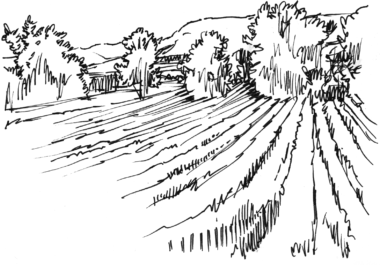
In the summer of 2001, standing alone amidst the oldest of our grapevines, feeling a deep connection to the land and to the past, I decided to start my own winery. I was working that morning in our original five rows of Pinot Noir, when it hit me that this work would not be truly satisfying unless I could eventually make my own wine from this fruit. It was my belief that we could craft a spectacular wine in very small quantities while still producing exceptional fruit for our winery clients. This blog is the continuing story of building our winery from the vineyard up. Our thoughts, our goals, our decisions, the good days and bad days. Enjoy.
’04 and ’05 Cabernet Sauvignon Tasting
The bottle you see above is one of a lot of two barrels of 2004 Cabernet Sauvignon, 100% sourced from Lowrey Vineyards. It was bottled last summer following two anxious years of aging in older French oak barrels. That lot is very special to us because it represents the first wine we will release under our yet-to-be-named winery label.
A couple of weeks ago, we bottled our 2005 Cabernet Sauvignon after a similar aging period in a somewhat different barrel regimen. The two barrels of ‘05s were initially aged in older Frenchies like the ’04s. After an initial tasting of the ‘05s, I surmised that adding an American oak barrel to the mix after the second racking (12 months in) would help frame the slightly bigger tannins and bolder overall mouthfeel.
It was one recent evening on our annual trip to Bobcaygeon that I decided to recruit some unbiased family palates to conduct our first ever cross-vintage wine tasting. Exciting stuff! After nervously setting up the blind tasting, I was intrigued to watch my father skip the aromatic profile altogether, swig back the wine and conclude that “It tastes good.” The more sophisticated family members assured me that both wines showed well and I was impressed that some were even able to recognize the subtle differences between vintages. Thanks guys!
Look for the ‘04s sometime soon and the ‘05s early next year after some quality time in bottle.
An undeniable (and at times dangerous) passion
My vineyard and wine philosophies will become clear over the course of these entries, but I stress that at my core I have a passion for what I do. This passion is anchored in the same sense of place that I hope to share in my wines.
For those interested in a similar path, I caution that at different times this passion has led to: tears, vinegar, “tractor ear” or selective hearing, the love of diesel fumes, a strange desire to talk to grapevines, the ability to hum the Weather Network theme, and occasional doubts of sanity. Most disturbingly, however, growing up on a grape farm has left me scarred for life with a chronic case of separation anxiety. My first failed attempt to leave the vineyard was four blurry years at the University of Guelph spent grinding out an honours degree in Microbiology. Over that time I became enamoured with yeast and fermentation dynamics, skills that would later come in handy as I ended up back home (surprise) completing a Masters degree in Viticulture at Brock University.
A second attempt at leaving home brought me to the “sunny” shores of Wolfville, Nova Scotia to run a small winery called Blomidon Estate. It was an amazing experience that thrust me into the challenging world of marketing and selling wine, while at the same time allowing me to hone my fledgling winemaking skills. After three rewarding vintages, I knew the time was right to return home to good old St. Davids and get to work on my new wine vision.
I relish the opportunity to finally craft wines from our own fruit. The goal is to let these wines give you a sense of place by showcasing our unique St. David’s Bench terroir. Individual varietals will be the focus: Pinot Noir, Cabernet Sauvignon, Shiraz, Pinot Gris and Sauvignon Blanc. That way I can really capture the subtle characters of each variety, and provide those interested with an appellation education in every bottle.
My Legacy
Over the coming weeks and months I hope to provide you with a raw, uncensored look at the travails and joys associated with opening a small, craft winery. Am I crazy? Perhaps. In fact, some have suggested just that. I would argue, however, that it may be the only way to satisfy my burning desire to make small quantities of great wine from our storied family vineyard.
Our farm dates back five generations to the days of David Jackson Lowrey, who planted Niagara’s first commercial vineyard in the late 1800s. Fast forward four generations to today and you’ll find my two personal heroes still farming this land. The vines have changed and the “tractors” don’t have legs anymore, but I’m sure my parents Howie and Wilma still worry about their crops the same way David Jackson did back in his day. Each generation has had to adapt and evolve with the times, and I see this small winery as my opportunity to do the same.
My parents bought the farm, so to speak, from my grandparents back in the 1970s when it was planted mainly with old Labrusca and Hybrid grapevines, which were common in Niagara at the time. My father and grandfather, the two Howards, worked as a formidable tandem to manage the farm, as my first vivid childhood memories can attest.
A sweeping grapevine pull-out program, prompted by the pending Free Trade agreement of the mid-80s, forced my parents to make many difficult and thankfully “wine-friendly” decisions. Amid the worries of a future without vineyards, it was Karl Kaiser of Inniskillin Wines who suggested that our site would be perfectly suited for the hard to grow, vinifera grape varieties that were beginning to show promise in the Niagara Region. So it was with skepticism and crossed fingers that we decided to plant five trial rows of Pinot Noir in 1987. The rest, as they say, is history. I can only hope that our new winery ensures that the farm is sustainable for generations to come.
The Lowrey Vineyard
Located in Niagara’s St. David’s Bench sub-appellation, the 5th generation Lowrey property is a 35 acre vineyard that produces craft wine grape varietals for customer wineries in the area. Lowrey wine grapes have supplied some of Canada’s most prestigious wines by accomplished winemakers and garnered many awards.
The Lowrey family has farmed the area for 5 generations. Current generations, Howard Lowrey and his son Wes Lowrey tend to the vineyard with a focus on achieving the most characteristic and complex examples that their varietals can produce.
Howard and his wife Wilma run the accomplished wine grape growing operation of Lowrey Vineyards while Wes, a Winemaker and Viticulturalist by training, crafts small batches of wine that exemplify the terroir of the St. Davids Bench and the style of the Lowrey Farm.
The St. Davids Bench is one of the recently designated sub-appellations recognized by the VQA as a distinct growing region and terroir within the Niagara Peninsula’s famed wine region. See VQA Ontario.

